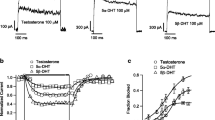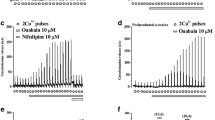Abstract
Caffeine elicits physiological responses in a variety of cell types by triggering the mobilization of Ca2+ from intracellular organelles. Here we investigate the effects of caffeine on intracellular Ca2+ concentration ([Ca2+]i) and ionic currents in anterior pituitary cells (GH3) cells. Caffeine has a biphasic effect on Ca2+-activated K+ current [I K(Ca)]: it induces a transient increase superimposed upon a sustained inhibition. While the transient increase coincides with a rise in [Ca2+]i, the sustained inhibition of I K(Ca) is correlated with a sustained inhibition of the L-type Ca2+ current. The L-type Ca2+ current is also inhibited by other agents that mobilize intracellular Ca2+, including thyrotropin releasing hormone (TRH) and ryanodine, but in a matter distinct from caffeine. Unlike the caffeine effect, the TRH-induced inhibition “washes-out” under whole-cell patch-clamp conditions and is eliminated by intracellular Ca2+ chelators. Likewise, the ryanodine-induced inhibition desensitizes while the caffeine-induced inhibition does not. Simultaneous [Ca2+]i and Ca2+ current measurements show that caffeine can inhibit Ca2+ current without changing [Ca2+]i. Single-channel recordings show that caffeine reduces mean open time without affecting single-channel conductance of L-type channels. Hence the effects of caffeine on ion channels in GH3 cells are attributable both to mobilization of intracellular Ca2+ and to a direct effect on the gating of L-type Ca2+ channels.
Similar content being viewed by others
References
Armstrong D, Eckert R (1987) Voltage-activated calcium channels that must be phosphorylated to respond to membrane depolarization. Proc Natl Acad Sci USA 84:2518–2522
Berridge MJ (1990) Calcium oscillations. J Biol Chem 265:9583–9586
Burgoyne RD, Cheek TR, Morgan A, O'Sullivan AJ, Moreton RB, Berridge MJ, Mata AM, Colyer J, Lee AG, East JM (1989) Distribution of two distinct Ca2+-ATPase-like proteins and their relationships to the agonist-sensitive calcium store in adrenal chromaffin cells. Nature 342:72–73
Butcher RW, Sutherland EW (1962) Adenosine 3′,5′-phosphate in biological materials. 1. Purification and properties of cyclic 3′,5′-nucleotide phosphodiesterase and use of this enzyme to characterize adenosine 3′,5′-phosphate in human urine. J Biol Chem 237:1244–1250
Endo M (1977) Calcium release from sarcoplasmic reticulum. Physiol Rev 57:71–108
Ferris CD, Snyder SH (1992) Inositol 1,4,5-trisphosphate-activated calcium channels. Annu Rev Physiol 54:469–488
Fredholm BB (1980) Are methylxanthine effects due to antagonism of endogenous adenosine? Trends Pharmacol Sci 1:129–132
Friel DD, Tsien RW (1992) Phase-dependent contributions from Ca2+ entry and Ca2+ release to caffeine-induced [Ca2+]i oscillations in bullfrog sympathetic neurons. Neuron 8:1109–1125
Gershengorn MC (1986) Mechanism of thyrotropin releasing hormone stimulation of pituitary hormone secretion. Annu Rev Physiol 48:515–526
Gross RA, Macdonald RL, Ryan-Jastrow T (1989) 2-Chloroadenosine reduces the N calcium current of cultures mouse sensory neurons in a pertussis toxin-sensitive manner. J Physiol (Lond) 411:585–595
Grynkiewicz G, Poenie M, Tsien RY (1985) A new generation of Ca2+ indicators with greatly improved fluorescence properties. J Biol Chem 260:3440–3450
Henzi V, MacDermott AB (1992) Characteristics and function of Ca2+- and inositol 1,4,5-trisphosphate-releasable stores of Ca2+ in neurons. Neuroscience 46:251–273
Horn R, Marty A (1988) Muscarinic activation of ionic currents measured by a new whole cell recording method. J Gen Physiol 92:145–159
Hughes AD, Hering S, Bolton TB (1990) The action of caffeine on inward Ba2+ current through voltage-dependent calcium channels in single rabbit ear artery cells. Pflügers Arch 416:462–466
Hughes M, Romey G, Duval D, Vincent JP, Lazdunski M (1982) Apamin as a selective blocker of the Ca2+ dependent K+ channel in neuroblastoma cells: voltage-clamp and biochemical characterization of the toxin receptor. Proc Natl Acad Sci USA 79:1308–1312
Ito Y, Kuriyama H, Suzuki H (1981) Excitation-contraction coupling in smooth muscle cells of the guinea-pig mesenteric artery. J Physiol (Lond) 321:513–535
Kalman D, O'Lague PH, Erxleben C, Armstrong DL (1988) Calcium-dependent inactivation of the diyhdropyridine-sensitive calcium channels in GH3 cells. J Gen Physiol 92:531–548
Kasai H, Aosaki T (1989) Modulation of Ca-channel current by an adenosine analog mediated by a GTP-binding protein in chick sensory neurons. Pflügers Arch 414:145–149
Kramer RH, Kaczmarek LK, Levitan EL (1991) Neuropeptide inhibition of voltage-gated calcium channels mediated by mobilization of intracellular calcium. Neuron 6:557–563
Law GJ, Pachter JA, Thastrup O, Hanley MR, Dannies PS (1990) Thapsigargin, but not caffeine, blocks the ability of thyrotropin-releasing hormone to release Ca2+ from an intracellular store in GH4C1 pituitary cells. Biochem J 267:359–364
Leijten PAA, VanBreeman C (1984) The effects of caffeine on the noradrenaline-sensitive calcium store in rabbit aorta. J Physiol (Lond) 357:327–339
Levitan ES, Kramer RH (1990) Neuropeptide modulation of single Ca2+ and K+ channels detected with a new patch clamp configuration. Nature 348:545–547
Lipscombe D, Madison DV, Poenie M, Reuter H, Tsien RW, Tsien RY (1988) Imaging of cytosolic Ca2+ transients arising from Ca2+ stores and Ca2+ channels in sympathetic neurons. Neuron 1:355–365
Matteson DR, Armstrong CM (1986) Properties of two types of calcium channels in clonal pituitary cells. J Gen Physiol 87:161–182
McPherson PS, Kim Y-K, Valdivia H, Knudson CM, Takekura H, Franzini-Armstrong C, Coronado R, Campbell KP (1991) The brain ryanodine receptor: a caffeine-sensitive calcium release channel. Neuron 7:17–25
Miller C, Moczydlowski E, Latorre R, Phillips M (1985) Charybdotoxin, a protein inhibitor of single Ca2+-activated K+ channels from mammalian skeletal muscle. Nature 325:442–444
Ritchie A (1987) Thyrotropin-releasing hormone stimulates a calcium-activated potassium conductance in a rat anterior pituitary cell line. J Physiol (Lond) 385:611–625
Rousseau E, LaDine J, Liu QY, Meissner G (1988) Activation of the Ca2+ release channel of skeletal muscle sarcoplasmic reticulum by caffeine and related compounds. Arch Biochem Biophys 267:75–86
Savineau JP, Mironneau J (1990) Caffeine acting on pregnant rat myometrium: analysis of its relaxant action and its failure to release Ca2+ from intracellular stores. Br J Pharmacol 99:261–266
Simasko SM, Weiland GA, Oswald RE (1988) Pharmacological characterization of two calcium currents in GH3 cells. Am J Physiol 254:E328-E336
Thayer SA, Perney TM, Miller RJ (1988) Regulation of calcium homeostasis in sensory neurons by bradykinin. J Neurosci 8:4089–4097
Toth PT, Torok TL, Magyar K (1990) Depolarization promotes caffeine induced [3H]-noradrenaline release in calcium-free solution from peripheral sympathetic neurons in vitro. Mol Pharmacol 34:664–673
Zholos AV, Baidan LV, Shuba MF (1991) The inhibitory action of caffeine on calcium currents in isolated intestinal smooth muscle cells. Pflügers Arch 419:267–273
Author information
Authors and Affiliations
Rights and permissions
About this article
Cite this article
Kramer, R.H., Mokkapatti, R. & Levitan, E.S. Effects of caffeine on intracellular calcium, calcium current and calcium-dependent potassium current in anterior pituitary GH3 cells. Pflugers Arch. 426, 12–20 (1994). https://doi.org/10.1007/BF00374665
Received:
Revised:
Accepted:
Issue Date:
DOI: https://doi.org/10.1007/BF00374665




